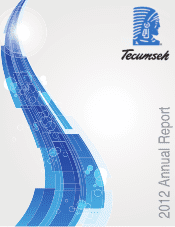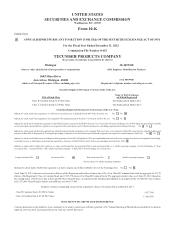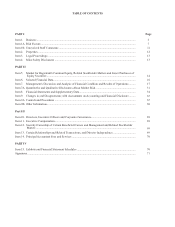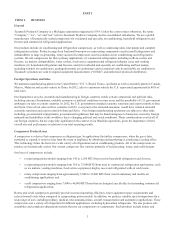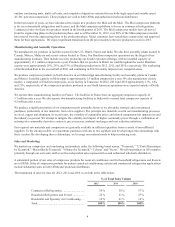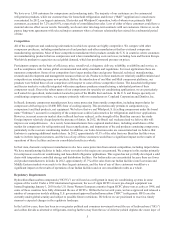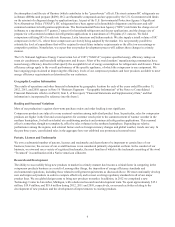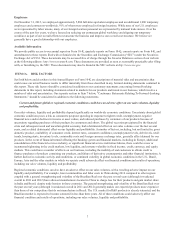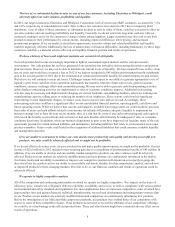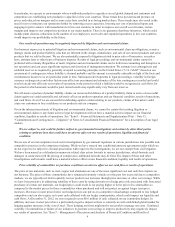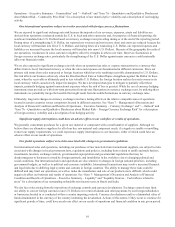Tecumseh Products 2012 Annual Report Download - page 9
Download and view the complete annual report
Please find page 9 of the 2012 Tecumseh Products annual report below. You can navigate through the pages in the report by either clicking on the pages listed below, or by using the keyword search tool below to find specific information within the annual report.8
The loss of, or substantial decline in sales to, any of our key customers, including Electrolux or Whirlpool, could
adversely affect our sales volumes, profitability and liquidity.
In 2012, our largest customers, Electrolux and Whirlpool Corporation, both of whom were R&F customers, accounted for 7.2%
and 6.6%, respectively of consolidated net sales. Sales to these two customers were down in 2012 due to temporary plant
shutdowns. Loss of either of these customers, or substantial declines in sales to either of them, could have an adverse effect on
our sales volumes and our resulting profitability and liquidity. Generally, we do not enter into long-term contracts with our
customers, making it easier for the customer to change volume among suppliers. Larger customers may also seek to use their
position to improve their performance by various means, including improved efficiency, lower pricing, and increased
promotional programs. If we are unable to meet their requirements, our sales volume and related profitability and liquidity
could be negatively affected. Additionally, the loss of market share or financial difficulties, including bankruptcy, by these large
customers could have a material adverse effect on our liquidity, financial position and results of operations.
We have a history of losses and might not maintain our current level of liquidity.
Our cash position has become increasingly important in light of constrained capital markets and the current economic
environment. Our cash position has not been generated from operations but instead by non-recurring divestitures and pension
plan reversions. However, we may not be able to maintain our current levels of liquidity. We have incurred losses in five of our
last six years and would have incurred a loss in 2012 if we had not recognized a $45 million postretirement benefit curtailment
gain in the second quarter of 2012 due to the termination of certain postretirement benefits for salaried employees and retirees.
We believe we will continue to incur net losses. Challenges remain with respect to our ability to generate appropriate levels of
liquidity solely from cash flows from operations, particularly uncertainties related to future sales levels, global economic
conditions, currency exchange effects and commodity pricing. We may not be able to generate cash from operating activities
unless further restructuring activities are implemented or sales or economic conditions improve. Additional restructuring
activities may be necessary and might include changing our current footprint, consolidating facilities, otherwise reducing our
manufacturing capacity, selling assets or reducing the number of our employees. These actions could result in significant
restructuring or asset impairment charges, severance costs, losses on asset sales and use of cash. Accordingly, these
restructuring activities could have a significant effect on our consolidated financial position, operating profit, cash flows and
future operating results. While we believe that current cash balances, available borrowings under our credit facilities, proceeds
from sales of assets and cash inflows related to non-income tax refunds will produce adequate liquidity to implement our
business strategy over at least the next twelve months, there is a risk that the costs of any such restructuring and cash required
will exceed the benefits received from such activities or that such benefits will ultimately be inadequate if sales or economic
conditions deteriorate. In addition, while our business dispositions in prior years have improved our liquidity, many of the sale
agreements provide for certain retained liabilities and indemnities, including liabilities that relate to environmental issues and
product warranties. Future events could result in the recognition of additional liabilities that could consume available liquidity
and management attention.
If we are unable to restructure to reduce our costs and increase productivity and quality and develop successful new
products, our sales could be adversely affected and we might not be profitable.
If we do not effectively reduce costs, increase productivity and make quality improvements we might not be profitable. Our net
income of $22.6 million in 2012 included a non-recurring gain due to a curtailment of postretirement benefits of $45 million. In
addition, if we are unable to develop and successfully market competitive products, our sales volumes could be adversely
affected. Products in our markets are relatively undifferentiated and new products are continuously introduced to the market.
Our future results and our ability to maintain or improve our competitive position will depend on our capacity to gauge the
direction of our key markets and on our ability to successfully and timely identify, develop, manufacture, market, and sell new
or improved products in these changing markets. If we fail to do so, our financial condition and results of operations could be
adversely affected.
We operate in highly competitive markets.
All of the compressor and condensing unit markets in which we operate are highly competitive. We compete on the basis of
efficiency, price, sound level, refrigerant, delivery, reliability, availability and service, as well as compliance with various global
environmental and safety standards and regulations. For most applications there are numerous competitors, some of which have
larger product lines and greater financial, technical, manufacturing, research and development and management resources than
we do. Products in our markets are relatively undifferentiated and competitors are continuously introducing new products.
Before the introduction of our Mini and Midi compressor platforms, our products were behind those of our competitors with
respect to some of these competitive factors. If our products do not meet or exceed the attributes of our competitors' offerings,
we could be at a disadvantage in the affected product lines. These and other factors might have a material adverse effect on our
results of operations.

